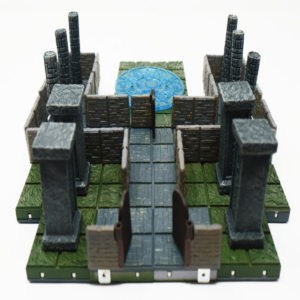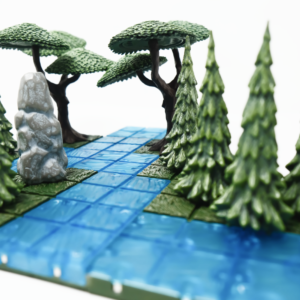D&D Grass Tiles
Showing all 6 resultsSorted by popularity
-

Hidden Temple Kit
$95.00 – $110.00Price range: $95.00 through $110.00 -

Ancient Woodlands Kit
$95.00 – $110.00Price range: $95.00 through $110.00 -

Pack of 12 Tiles | Grass & Stone
$30.00 – $35.00Price range: $30.00 through $35.00 -

Pack of 12 Tiles | Grass & Water
$30.00 – $35.00Price range: $30.00 through $35.00 -

Pack of 12 Tiles | Grass & Sand
$30.00 – $35.00Price range: $30.00 through $35.00 -

Pack of 12 Tiles | Castle & Grass
$30.00 – $35.00Price range: $30.00 through $35.00
Epochscapes’ D&D Grass Tiles
Let’s be honest, D&D grass tiles are much better at imitating nature than green marker on a whiteboard.
We worked so hard to get the authentic look and feel of grass with our grass tiles. We’re confident you’ll love them!
So, if you’re looking to elevate your game and engage your players on a whole new level, stick around. There’s a lot to share about these game-changing accessories. From their uses to their benefits, we’ll dive into everything you need to know about our D&D grass tiles.
Importance of Landscape in D&D Games
Landscape matters. It’s not just us saying this, but a legion of D&D enthusiasts would echo the sentiment too. A well-crafted backdrop goes a long way in transforming the gaming experience. It sets the tone, molds the story, and it’s the canvas on which the thrilling D&D adventures unfold.
D&D Grass tiles come into the picture here. They don’t just serve an aesthetic purpose, adorning your table setup. They play a pivotal role in setting up the landscape of the game, rendering unparalleled immersion, which is a key aspect of D&D games. But why does the landscape have such a stronghold in shaping the gaming experience? Let’s have a tap into this.
Apart from the aesthetic purpose, the landscapes in D&D games influence the storyline and the way your characters interact with the environment. Imagine a rough terrain or a thick forest. The challenges that the adventurers would face definitely enhances the game’s dynamics. Additionally, these landscapes even direct the adventurer’s journey, forming an integral part of gameplay structuring.
The landscape isn’t a mere background. It’s like a silent character, influencing the game as much as the rest of your troupe. Every shrub, each little rock, even the grassy paths through D&D grass tiles may hide opportunities or obstacles alike. The environment may hide treasures, contain hostile creatures; it’s an unpredictable entity.
In a nutshell, the landscape adds depth to the game. It takes players from a plain tabletop to a lively, vibrant world, steering away from the ordinary role-playing games which are mere character-driven narratives. It transforms your gaming session into a virtual world exploration, cranking the adventure quotient several notches higher. The D&D grass tiles add to the intricacies of the vistas you create, enabling you to develop more impactful and immersive narratives. A fair warning though, once the charm of these landscapes sets in, there’s no looking back. Prepare to have your D&D sessions leveled up!
The role of landscapes in D&D games can’t be overlooked. However, the true potential lies in apt utilization and imaginative use of components like the D&D grass tiles. In the following section, we’ll delve into the craftsmanship and the key uses of D&D grass tiles more explicitly.
Enhancing the Gaming Experience with Grass Tiles
As an experienced D&D player, I cannot overstate the impact of the game’s physical landscape. It’s more than just visual appeal. In fact, it’s a silent character in the gameplay itself. As such, elements like D&D grass tiles play an integral part in shaping the game’s dynamics and narratives.
Using D&D grass tiles creatively can stimulate players’ engagement and immersion significantly. Placing them strategically on the gaming table could transform a straightforward situation into a thrilling one. For instance:
- If the players need to cross an open field, stacking the tiles can produce 3D models of hills.
- Want to set up an ambush scenario? Hide a fearsome monster token beneath a stack of grass tiles.
- How about transforming empty areas into woods by clustering tiles closer together?
The opportunities are endless with D&D grass tiles, whether we’re talking about enhancing a narrative or adding a layer of complexity to the tabletop gaming experience. This level of creativity and innovation makes every game unpredictable and engaging.
And let’s not forget the importance of the nature of the terrain. Open grasslands, after all, are different from bustling cityscapes or treacherous mountain passes. These modifications not only set the tone of the adventure but also determine how players strategize their moves. It’s not just about how the landscape looks – it’s also about the tactical implications it brings.
Collectively, these elements contribute to the overall gaming experience, offering surprises and challenges to players. With D&D grass tiles, players can anticipate a more immersive and dynamic D&D session – an adventure truly worth embarking upon. While imagination is a key component of any D&D game, with the right use of these versatile tiles, the game’s terrain can almost come to life in front of the players’ eyes. And with that, the excitement simply rises to a whole new level.
Benefits of Using Grass Tiles in Your Campaign
Venturing into the world of D&D grass tiles as a Dungeon Master (DM) is a journey of discovery and adventure, just like the campaigns you run. Using grass tiles can greatly enhance your campaign on multiple levels.
During my years as a DM, I’ve found that using grass tiles enhances immersion. Players can visualize the environment more easily, which leads to a more impactful experience. Being able to see where their characters are enhances the role-play aspect of the game. It’s like when you read a really well-written novel and you feel as if you’re right there in the scene. That’s the effect that grass tiles can have.
One huge advantage I’ve noticed is that each type of grass tile can set a different tone for encounters. For instance, Basic Grass Tiles are perfect for routine travel or simple encounters, while High-Grass Tiles create suspense as players anticipate an ambush. Marsh Grass Tiles introduce an element of challenge and struggle against nature. Meadow Tiles give a lighter air – maybe it’s time for some light-hearted role-play or attempts at diplomacy. Grassland Hill Tiles can literally add another dimension to your game by allowing you to add hills and valleys.
D&D Grass tiles offer strategic possibilities for combat encounters too. For instance, High-Grass Tiles can offer players hidden spots to attack from – Or to be attacked by lurking creatures!
Finally, D&D grass tiles add diversity and depth to your world-building efforts. When you use different types of grass tiles, you’re demonstrating your world’s natural diversity. Variation in terrain can also mean variation in flora, fauna, and cultures. This depth can, in turn, inspire characters to interact more with the environment, stimulate more engaging storytelling, and result in a more involving gaming experience.
How to Incorporate Grass Tiles Into Your Game
Immersing players in a captivating D&D campaign isn’t just about narrating an enticing storyline. It’s equally about presenting a visually engaging environment. That’s where grass tiles step in. But how exactly do you incorporate these tiles into your game? Well, let’s delve into that.
Selecting the Right Grass Tiles
My first piece of advice is to choose your grass tiles wisely. They come in various forms, each embodying a different feeling or tone. Want to depict a tranquil meadow, choose tiles depicting lush green grass swaying gently in the breeze. For an eerie, ominous setting, opt for dried, withering grass tiles. Being selective about these tiles is crucial since they set the stage for your storytelling.
Introducing Grass Tiles in Gameplay
Next, think about how you can introduce these tiles in your gameplay. Remember, D&D is inherently dynamic and interactive. You can use the tiles to shape travel encounters, prompting unexpected ambushes or serene respites. They can also add a tactical layer to combat scenarios. After all, fighting in a grassy field is different from battling in a claustrophobic dungeon.
Moreover, don’t shy away from allowing players to interact with the grass tiles directly. Maybe the rogue locates a hidden trap door obscured by dense undergrowth. Perhaps the wizard draws on nature’s energy, manipulating the grass to hinder approaching enemies. Gaming elements like these enhance immersion and role-playing experiences drastically.
Building an In-Game World Using Grass Tiles
Lastly, think about how grass tiles contribute to your world-building efforts. How do the plane’s flora and fauna react to the grassy environment? What sort of creatures make these grasslands their home? Exploring these aspects not only makes your world feel more believable but also inspires interactive storytelling and strategic gameplay.
Stay tuned; I’ll continue to divulge more tips and insights on effectively using D&D grass tiles in the next sections of this article.
Conclusion
I’ve shared the ins and outs of using D&D grass tiles in your campaigns. They’re not just for looks; they can profoundly impact gameplay and storytelling. The right tiles can set the mood, whether it’s a serene meadow or a foreboding wilderness. They offer more than just a backdrop; they’re tools for immersion, enhancing travel encounters and combat scenarios. Players can interact with them, adding depth to their role-playing. And let’s not forget world-building; the environment can shape the flora, fauna, and narrative. So next time you’re planning a campaign, don’t overlook the power of grass tiles. They’re a small detail with a big impact. You won’t regret making them part of your D&D toolkit.
